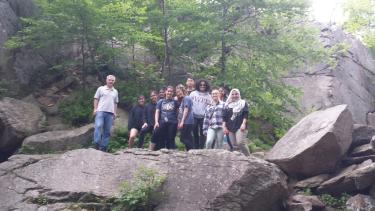REU Program

Our REU proposal is currently under consideration at the NSF. We will post a status update as soon as we receive a funding update.
WPI’s Department of Chemistry and Biochemistry is hosting undergraduate students from around the country at a new NSF-sponsored Research Experience for Undergraduates site. As an NSF-funded project, only US citizens and permanent residents are eligible for support. You will participate in projects ranging from membrane biochemistry to bio-inspired materials synthesis all geared toward solving important problems in biology. WPI undergraduates are not eligible for the REU, but can obtain support for summer research through the SURF program. Application and eligibility questions can be directed toward the site director Shawn Burdette (scburdette@wpi.edu) or co-director Ron Grimm (rlgrimm@wpi.edu). General inquiries can be directed to gr-cbc-reu@wpi.edu.
PROGRAM SUPPORT—Students will receive a stipend of $7,000, a free WPI dormitory room in housing dedicated to participants in various WPI REU sites, and a travel subsidy.
ACADEMIC PROGRAM—In addition to research activities, students will have the opportunity to participate in a weekly seminar series with topics that include career development, scientific ethics, and students research presentations.
CONFERENCES—Students will participate in a summer research conference with other WPI REU sites and two students will have the opportunity to present at an ACS National Meeting.
SOCIAL EVENTS—Throughout the summer, various social events will be planned including cookouts, a whitewater rafting trip, hiking excursions, a trip to Boston, a classical concert at Tanglewood, and opportunities to attend sporting events.
Choosing your summer project
You will provide as part of the application process your top three choices from the projects listed below where you will pursue your research in a group of scholars. Several of these projects are multiple student/mentor projects, in which each REU students will work with a different mentor on separate aspects of a larger project.
Coming Soon
New and updated project descriptions will be posted when funding is approved.
Publications with former WPI REU co-authors
REU students' names are in bold
8. Mrinmoy Das, Leila Zamani, Christopher Bratcher and Patricia Z. Musacchio. J. Am. Chem. Soc. 2023. Azolation of Benzylic C–H Bonds via Photoredox-Catalyzed Carbocation Generation.
7. Lela Jackson, Madison Rennie, Alison Poussaint and Suzanne Scarlata. Sci. Rep. 2022, 12, 8758. Activation of Gαq sequesters specific transcripts into Ago2 particles
6. Andre F.C.Vieira, Mark A.Xatse, HamideTifeki, CédricDiot, Albertha J.M.Walhout and Carissa Perez Olsen. J. Biol. Chem. 2022, 298, 101444. Monomethyl branched-chain fatty acids are critical for C. elegans survival in elevated glucose conditions
5. John P. Cvitkovic, Connor D. Pauplis, Phoebe C. Carney and George A. Kaminski. J. Comput. Biophys. Chem. 2021, 20, 141-152. Expansion and Additional Validation of PKA17: A Fast Real-Time and Web-Based pKa Predictor
4. Jingjing Yan, Rick Homan, Corrianna Boucher, Prem Basa, Katherine Fossum, Ron Grimm John MacDonald and Shawn Burdette. Photochem. Photobiol. Sci. 2019, 18, 2849–2853. On-Demand Guest Release from MOF-5 Sealed with Nitrophenylacetic Acid Photocapping Groups
3. Rick A. Homan, Dalton S. Hendricks, Thomas M. Rayder, U Shwe Thein, Katherine J. Fossum, Adriana P. Claudio Vázquez, Jingjing Yan, Ronald L. Grimm, Shawn C. Burdette and John C. MacDonald. Cryst. Growth Des. 2019, 19, 6331–6338. A Strategy for Trapping Molecular Guests in MOF-5 Utilizing Surface Capping Groups
2. Rameez Ali, Yong Guan, Alexandria N. Leveille, Elizabeth Vaughn, Sangram Parelkar, Paul R. Thompson and Anita E. Mattson. Eur. J. Org. Chem. 2019. 6917-6929. Synthesis and Anticancer Activity of Structure Simplified Naturally Inspired Dimeric Chromenone Derivatives.
1. John P. Cvitkovic, Connor D. Pauplis and George A. Kaminski. J. Comput. Chem. 2019, 40, 1718-1726. PKA17—A Coarse‐Grain Grid‐Based Methodology and Web‐Based Software for Predicting Protein pKa Shifts.